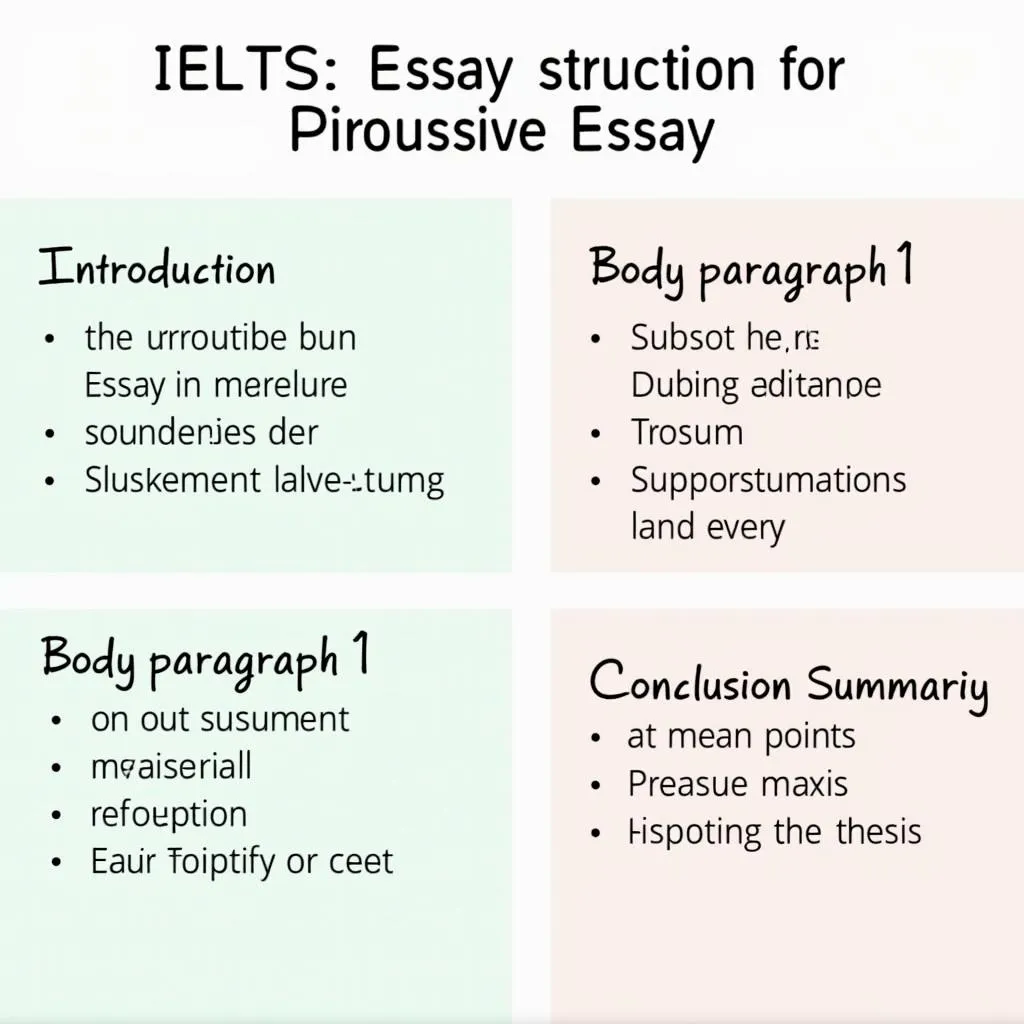Understanding the Persuasive Essay in IELTS Writing Task 2
The persuasive essay is a common type of essay in IELTS Writing Task 2. It requires candidates to present a clear argument and convince the reader to agree with their point of view. Understanding the structure and key elements of a persuasive essay is crucial for success in this task.
Key Elements of a Persuasive Essay
- Clear thesis statement
- Logical arguments supported by evidence
- Counterarguments addressed
- Strong conclusion reinforcing the main point

Effective Planning Strategies
Before diving into writing, it’s essential to plan your essay effectively. This will help you organize your thoughts and ensure a coherent argument.
Planning Tips:
- Analyze the question carefully
- Brainstorm ideas and arguments
- Choose the strongest points to include
- Outline your essay structure
Crafting a Compelling Introduction
Your introduction sets the tone for your entire essay. It should grab the reader’s attention and clearly state your position on the topic.
Tips for Writing a Strong Introduction:
- Start with a hook (e.g., a surprising fact, question, or anecdote)
- Provide background information on the topic
- Present your thesis statement clearly and concisely
Example:
“In today’s digital age, the debate over social media’s impact on society has intensified. While some argue that these platforms have revolutionized communication, I firmly believe that the negative consequences of social media outweigh its benefits.”
Developing Persuasive Body Paragraphs
Your body paragraphs are where you present your arguments and supporting evidence. Each paragraph should focus on a single main idea that supports your thesis.
Tips for Effective Body Paragraphs:
- Start with a clear topic sentence
- Provide specific examples and evidence
- Explain how the evidence supports your argument
- Use transitional phrases to connect ideas
Example:
“Firstly, social media has been shown to have detrimental effects on mental health. Studies have consistently linked excessive social media use to increased rates of depression and anxiety among young adults. For instance, a 2018 study by the University of Pennsylvania found that limiting social media use to 30 minutes per day resulted in significant reductions in loneliness and depression.”
Addressing Counterarguments
Acknowledging and refuting counterarguments strengthens your essay by demonstrating a balanced perspective and critical thinking skills.
Tips for Addressing Counterarguments:
- Identify potential opposing viewpoints
- Present the counterargument fairly
- Provide a strong rebuttal
- Use concessive language (e.g., “While it’s true that…, however…”)
Example:
“While proponents of social media argue that it facilitates global connectivity, the reality is that these platforms often create echo chambers that reinforce existing beliefs. Although users can theoretically connect with diverse individuals worldwide, algorithms tend to show content that aligns with users’ existing views, limiting exposure to different perspectives.”
Writing a Powerful Conclusion
Your conclusion should reinforce your main argument and leave a lasting impression on the reader.
Tips for an Effective Conclusion:
- Restate your thesis in a fresh way
- Summarize your main points
- End with a call to action or thought-provoking statement
Example:
“In conclusion, the negative impacts of social media on mental health, privacy, and societal discourse far outweigh its purported benefits. As we navigate the digital landscape, it is crucial to critically evaluate our relationship with these platforms and consider implementing stricter regulations to mitigate their harmful effects. Only by addressing these issues can we hope to harness the true potential of social media while safeguarding individual and societal well-being.”
Language and Style Tips
Using appropriate language and style is crucial for crafting a persuasive essay that resonates with the reader.
Key Language and Style Tips:
- Use a formal tone
- Employ a variety of persuasive techniques (e.g., ethos, pathos, logos)
- Utilize advanced vocabulary and complex sentence structures
- Incorporate rhetorical questions to engage the reader
- Use emphatic language to strengthen your points
Example:
“Isn’t it time we recognized the insidious nature of social media addiction? The compelling evidence presented unequivocally demonstrates the urgent need for action.”
Practice and Review
Improving your persuasive essay writing skills requires consistent practice and thoughtful review.
Tips for Improvement:
- Write practice essays on a variety of topics
- Time yourself to simulate exam conditions
- Ask for feedback from teachers or peers
- Analyze high-scoring sample essays
- Keep a vocabulary journal of persuasive phrases and transitional expressions
By following these tips and practicing regularly, you can significantly enhance your ability to write compelling persuasive essays for IELTS Writing Task 2. Remember, the key to success lies in presenting a clear, well-structured argument supported by relevant evidence and expressed in fluent, accurate English.